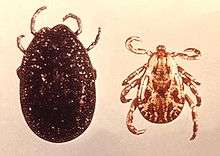Borrelia anserina
| Borrelia anserina | |
|---|---|
| Scientific classification | |
| Domain: | Bacteria |
| Phylum: | Spirochaetes |
| Order: | Spirochaetales |
| Family: | Spirochaetaceae |
| Genus: | Borrelia |
| Species: | B. anserina |
| Binomial name | |
| Borrelia anserina Sakharoff 1891; Bergey et al. 1925 | |
Borrelia anserina is a helical spirochete bacterium with dimensions around 8-20/0,2-0,3 µm and with five to eight spirals. Their mobility is very high. B. anserina can be colored with the May Grunwald-Giemsa method.[1]
Cultivation
In microbiological laboratories, B. anserina bacteria can be grown on special protein-enriched media (rich in ovoalbumins or animal tissue (that contains myoglobin)), in anaerobic conditions. They can also be grown in embrionic chicken eggs. The laboratory cultivation of B. anserina is rarely done and constitutes a diagnostic method in bird borreliosis and spirochetosis.[1] Borrelia anserina solía mantenerse en huevos embrionarios de pollo o por pases en serie en pollos domésticos hasta que en 1986 se descubrió que podía ser cultivada en medio Barbour-Stoenner-Kelly (BSK) lo que facilitó e hizo más costeables las futuras investigaciones.
Pathogenity
B. anserina is a pathogenic agent for poultry (chickens, turkeys, ducks etc.) and causes a disease called borreliosis or spirochetosis. This bacterium is transmitted from bird to bird by ticks from the Argas and Ornitodorus genera. The major symptoms of an infection with B. anserina are: anemia, diarrhea, and severe neurological dysfunctions.

References
- 1 2 Gheorghe Rapunteanu, Sorin Rapunteanu (editors) (2005). Bacteriologie Veterinara Speciala (I ed.). Editura AcademicPress, Cluj-Napoca, Romania. ISBN 973-7950-95-X.
Further reading
Ataliba, Alexandre C.; Resende, Jose ́ S.; Yoshinari, Natalino; Labruna, Marcelo B. (October 2007). "Isolation and molecular characterization of a Brazilian strain of Borrelia anserina, the agent of fowl spirochaetosis". Research in Veterinary Science. 83 (2): 145–149. doi:10.1016/j.rvsc.2006.11.014.